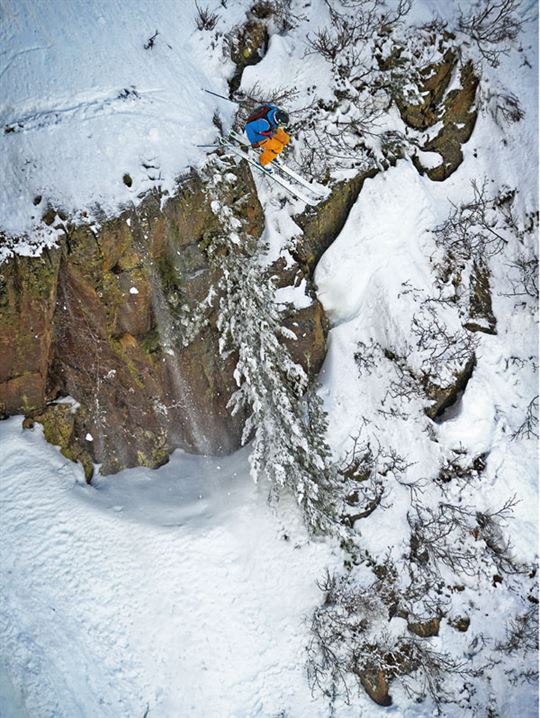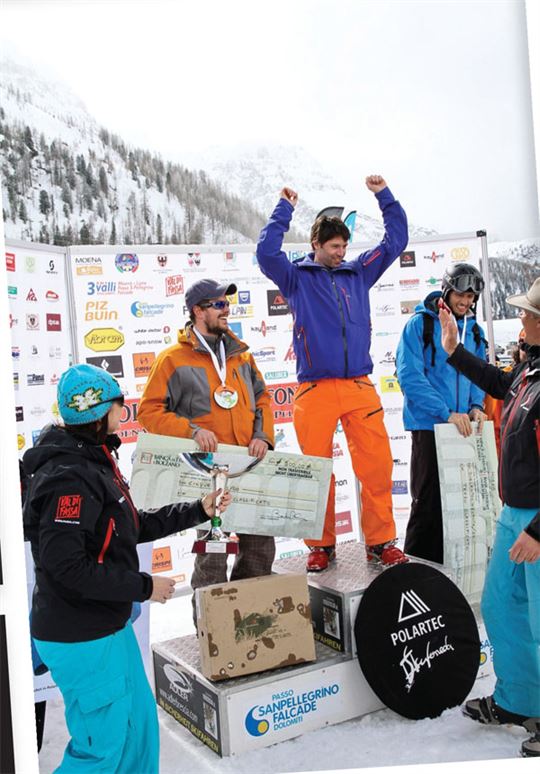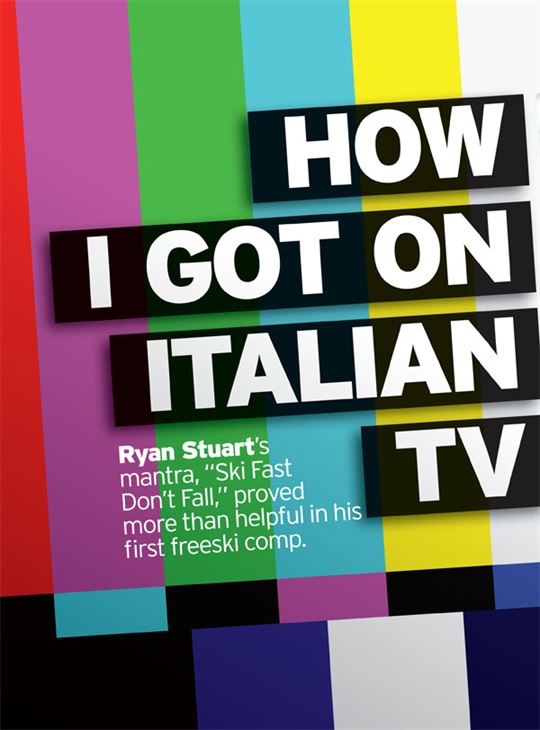“Pronto?” the voice at the starting gate asked me, one of about six words I knew in Italian.
by Ryan Stuart in Fall 2013 issue
“Am I ready? Hell, no!” I remember thinking. My helmet sat in my hands as I fiddled with the GoPro. My mouth dry and pasty, I wished I had taken another drink of water. I couldn’t tell what was off the blind rollover two turns into the run and I still hadn’t decided if I should go hard right at the bottom or off the small cliff. Then I looked up and noticed the helicopter hovering a hundred metres off the mountain face, a guy hanging out the side with his camera—pointing at me. He looked impatiently bored.
“Ah…almost ready,” I replied, sliding the helmet onto my head and fumbling with the chin clip. After three failed attempts, start-gate guy Fabrizio took pity and clipped it for me, something my nine-year-old won’t let me do. And through the whole procedure, the helicopter hovered, the camera rolled—and Italian sport fans watched. Sciocco Canadese, silly Canadian.
But I didn’t have time for shame; it was time to ski. “Rrrrree-Anno,” Fabrizio called into his radio (stumbling on the “y” in my name, a letter that doesn’t exist in the Italian alphabet), “Stuardo” (I was getting used to having either an “o” or “i” added to my surname) and finally (before the gatekeeper counted down “Tre, due…”), the command to drop: “Saltando!”
I know I should have been focused on my run, where to turn, what route to take, but in that moment one thought filled my head: How in the hell did I end up in a freeskiing competition half-way across the world, and broadcast on Italian television?
The Polartec Scufoneda first entered my lexicon a few years earlier at a Boston steak joint. Nate Simmons, Polartec’s marketing manager and a fellow telemark skier, was telling me about the week-long tele-festival in the Italian Dolomites. He had gone the year before and competed in the marquee freeride contest on the Col Margherita Freeride Park. He told me all about it, including how he had hidden behind a rock on his run as he tried to hide from the helicopter and take a break.
A few glasses of wine later the Scufoneda faded into a blur and the helicopter detail totally disappeared. Then early last winter Simmons invited me to join a small group he was taking to the festival. Of course I said yes. And the next email: Oh, and did I want to compete in the freeride contest?
The smart answer would have been: “No thanks.” I haven’t raced on skis since high school, almost 20 years ago, and never, since I started telemarking. In fact, I’d never been in any freeride contest. I’m willing to drop into just about every named run at Whistler Blackcomb, but I’m no free-heel Nick DeVore star. I don’t huck off cliffs, carve at Mach speed or throw flips. And then there was the foggy memory of Simmons’ quad-crushing experience. Despite it all, I replied: classic “Sign me up.”
Two months later, and there I was, standing at the starting gate for my qualifying round.
After a red-eye flight to Munich, a five-hour drive to Moena and then two days of getting my ski legs accustomed to Italian snow, I woke up on contest day nervous and nauseous, though that may have been the previous night’s “exercise”—grappa!
After a rugged morning of following the other competitors like a lamb—collecting bibs, staring at the racecourse, drinking more espresso, staring at the racecourse, searching for a WC and staring at the racecourse some more, I tried to set a line to memory. Standing at the top, I couldn’t remember a single detail beyond the basics. Below me sat a big bowl that led into craggy terrain full of gnarled larch, rocks, rolls, cliffs and finally a finish line banner. Far below in Passo San Pellegrino, I could hear the loudspeaker announcing the competition and imagine the words, in heavy Italian accent, it would soon say, “Ryan Stuart is approaching the big cliff. He looks like he’s going to drop…. No wait, he’s pulled up. What’s he doing? He’s just standing there and now it looks like he’s sidestepping away. No, he’s slipped and he’s going off headfirst…it does appear his helmet is secure.”
Shaking off the nightmare, I dropped in. Out of the gate I made a few tight turns and then opened it up. A rock band suddenly appeared and I jumped over it, flying through the air and landing softly. A couple more turns led to the more convoluted terrain on the lower face. Skiing blindly, I dropped over a couple of rolls to find small cliffs, but managed to hang on. By now my legs were screaming and my lungs ached. One pathetic fall later, the finish was just across a cross-country ski track. As I dropped onto it, my side—just short of the finish—with a crowd of people staring at me. A few quick skates later, I crossed the finish line thoroughly humbled.
I disappeared for the rest of the day skiing laps on the nearby lifts, feeling relieved I wouldn’t be qualifying for the final round. But apparently the Italians like a good clown. I qualified 3rd in the Telemark category. Instantly the nausea returned.
The next morning, we pulled into San Pellegrino to find a helicopter parked near the finish line. I asked Simmons about it. “It’s for filming the finals,” he said. “It’s broadcast on Italian television.” Right. The helicopter part of Simmons’ story suddenly resurfaced. Not only was I in the finals of a freeride contest, but it was going to be on TV.
“So, what rock did you hide behind?”
Despite my best attempts, I again failed to memorize a line. And so as Fabrizio clipped on my helmet again, a cameraman sat waiting in the hovering helicopter and the countdown began. I had no idea where I was going to go after my second turn. In the moment before I pushed off I made a simple game plan: ski fast; don’t fall. And that’s just what I did. Swooping turns on the technical terrain near the start led into a treeless apron where I opened it up, trying to conserve energy for the trees. As my legs started to burn, I dropped into a shallow gully and arced back and forth, tracing the wavering line of out of control. Near the bottom I popped out into an opening and saw a perfect jump. Feeling guilty that I hadn’t taken any air yet, I lined it up and launched into the biggest spread-eagle of my life.

photo: MATTEO ZANGA/POLARTECH
A few hours later I stood in a crowd of people waiting for the results to be announced. The man on the mic squawked away in Italian and one of the skiers scrambled up to stand beside the podium. More squawks and 4th and 3rd were there, too. I couldn’t believe it. Then 2nd was called, after which the announcer switched mostly to English. “And il campione in the Telemark dee-visione, from Canada: Rrrree-Anno Stuardo!”
One huge trophy and a giant cheque later I was spraying Italian sparkling wine all over the place. Even writing this now it sounds ridiculous: I won €1,000 in a telemark freeski competition in Europe. And I was on Italian TV. No, seriously.

Super Dolomiti
The stats are impressive: 1,200 km of runs, 12 resort areas, 450 lifts—and only one ski pass. Passo San Pellegrino, the home of the Scufoneda festival, is one tiny part of the aptly named Dolomiti Superski, an even bigger conglomerate of resorts in the Italian Dolomites, including Val Gardena and Cortina d’Ampezzo, united under the world’s biggest lift pass. dolomitisuperski.com
Several of the resorts seamlessly link together, while others require a short taxi or bus ride. But what unites them as much as the single pass is the variety of terrain, lots of off-piste, and the orange rock walls and peaks that have earned the region a UNESCO World Natural Site designation. Oh, and the food. No matter where you go you are never far from a refugio or bar serving generous portions of in-house prepared meat, cheese, homemade pasta and espresso.




